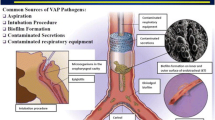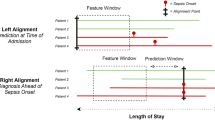Abstract
When intensive care for newborns was introduced thirty years ago its primary goal was to improve the rates of survival of sick and premature infants. Medicine has been successful in attaining this goal; however, as more infants survive, the cost of intensive care and the additional cost of services and care for handicapped survivors continue to escalate. In order to curb the increasing cost of newborn intensive care, heightened initiatives directed at the prevention of premature births will be necessary.
Similar content being viewed by others
References
Avery, M. E., and J. Mead 1959 Surface Proteins in Relation to Atelectasis in Hyaline Membrane Disease.American Journal of Diseases of Children 97:517–523.
Boyle, M. H., G. W. Torrance, J. C. Sinclair, and S. P. Horwood 1983 Economic Evaluation of Neonatal Intensive Care of Very-low-birth-weight-infants.New England Journal of Medicine 308:1330–1337.
Campbell, A. G. M. 1982 Which Infants Should Not Receive Intensive Care?Archives of Disease in Childhood 57:569–571.
Centers for Disease Control 1990 Low Birthweight-United States, 1957–87.Morbidity and Mortality Weekly Review 39:148–151.
Committee on Perinatal Health 1976Toward Improving the Outcome of Pregnancy: Recommendations for the Regional Development of Maternal and Perinatal Health Services. White Plains, New York: March of Dimes, Birth Defects Foundation.
Enhorning, G., A. Shennan, and F. Possmayer et al. 1985 Prevention of Neonatal Respiratory Distress Syndrome by Tracheal Instillation of Surfactant: A Randomized Clinical Trial.Pediatrics 76:145–153.
Expert Panel on the Content of Prenatal Care 1989Caring for Our Future: Content of Prenatal Care. Washington, D.C.: Department of Health and Human Services, Public Health Service.
Gregory, G. A., J. A. Kitterman, and R. A. Phibbs et al. 1971 Treatment of Idiopathic Respiratory Distress Syndrome with Continuous Positive Airway Pressure.New England Journal of Medicine 284:1333–1336.
Gruenwald, P. 1947 Surface Tension as a Factor in the Resistance of Neonatal Lungs to Aeration.American Journal of Obstetrics and Gynecology 53:996–998.
Hack, M., and A. A. Fanaroff 1986 Changes in the Delivery Room Care of the Extremely Small Infant (<750 gm): Effects on Morbidity and Outcome.New England Journal of Medicine 314:660–664.
Horbar, J.D., R. F. Soll, and J. M. Sutherland et al. 1989 A Multicenter Randomized Placebo-controlled Trial of Surfactant Therapy for Respiratory Distress Syndrome.New England Journal of Medicine 320:887–891.
Kitchen, W. H., V. Y. U. Yu, and A. A. Orgill et al. 1982 Infants Born before 29 Weeks Gestation: Survival and Morbidity at 2 Years of Age.British Journal of Obstetrics and Gynecology 89:887–891.
National Association for Perinatal Addiction Research and Education 1989 New Research Compares Drug Use by Public and Private Patients. Update, November. (Newsletter)
Office of Technical Assessment 1987Neonatal Intensive Care for Low Birthweight Infants: Costs and Effectiveness. Health Technology Case Study 38. Washington, D.C.: U.S. Congress.
Papiernik, E., J. Bouyer, and J. Dreyfus et al. 1985 Prevention of Preterm Births: A Perinatal Study.Pediatrics 76:154–158.
Rhoden, N. K. 1986 Treating Baby Doe: The Ethics of Uncertainty.Hastings Center Report 16:34–42.
Schechner, S. 1980 For the 1980s: How Small Is Too Small?Clinical Perinatology 7:135–143.
Walker, D. B., A. Feldman, B. R. Vohr, and W. Oh 1986 Cost-benefit Analysis of Neonatal Intensive Care for Infants Weighing Less Than 1,000 Grams at Birth.Pediatrics 74:20–25.
Yu, V. Y. H., J. L. Loke, and B. Bajuk 1986 Prognosis for Infants Born at 23–28 Weeks Gestation.British Medical Journal 293:1200–1203.
Author information
Authors and Affiliations
Additional information
Dr. Papile is a professor of pediatrics at the University of New Mexico School of Medicine in Albuquerque, where she is Director of the Neonatology Fellowship Program. Her primary research interest is neonatal brain injury. She is a principal investigator of the National Institute of Child Health and Human Development’s Multicenter Network of Neonatal Intensive Care Units grant, a five-year, 12-center initiative to assess the efficacy of widespread treatment modalities in neonatal intensive care. In 1992, as a Congressional Fellow with the Select Committee for Children, Youth and Families, she studies health care reform initiatives and their potential impact on the health care of women and children.
Rights and permissions
About this article
Cite this article
Papile, LA. Predicting the future for newborns requiring intensive care. Human Nature 5, 95–102 (1994). https://doi.org/10.1007/BF02692193
Received:
Revised:
Issue Date:
DOI: https://doi.org/10.1007/BF02692193




